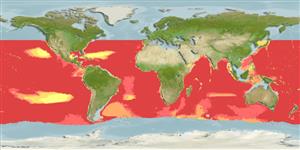>
Myctophiformes (Lanternfishes) >
Myctophidae (Lanternfishes) > Lampanyctinae
Etymology: Ceratoscopelus: Greek, keras, -atos = horn + Greek, skopelos = a lantern fish (Ref. 45335).
More on author: Lütken.
Environment: milieu / climate zone / depth range / distribution range
Ecología
marino batipelágico; oceanodromo (Ref. 51243); rango de profundidad 391 - 2056 m (Ref. 27311). Deep-water; 42°N - 65°S, 180°W - 180°E
Atlantic Ocean: 35°N (eastern limit) and 42°N (western limit) south to the Subtropical Convergence. Pacific Ocean: tropical and subtropical waters (Ref. 4066). Indian Ocean: 20°N-45°S (Ref. 4066). Reported to be common in southern Africa (Ref. 4066). South China Sea and East China Sea (Ref.74511).
Length at first maturity / Tamaño / Peso / Age
Maturity: Lm ?, range 5 - ? cm
Max length : 10.2 cm TL macho / no sexado; (Ref. 125989); peso máximo publicado: 11.40 g (Ref. 125989)
Espinas dorsales (total): 0; Radios blandos dorsales (total): 13-15; Espinas anales 0; Radios blandos anales: 13 - 15
Oceanic species found between 700 and 1,500 m during the day; between 20 and 200 m at night (Ref. 4775) with maximum abundance between 50 and 100 m (Ref. 47377). Size stratification with depth both day and night (Ref. 4775). Small juveniles (1.5-1.9 cm) are apparently non-migratory. Known to feed on zooplankton but appears to be adapted for occasional herbivory (Ref. 28809).
Life cycle and mating behavior
Madurez | Reproducción | Puesta | Huevos | Fecundidad | Larva
Hulley, P.A., 1990. Myctophidae. p. 398-467. In J.C. Quero, J.C. Hureau, C. Karrer, A. Post and L. Saldanha (eds.) Check-list of the fishes of the eastern tropical Atlantic (CLOFETA). JNICT, Lisbon; SEI; Paris; and UNESCO, Paris. Vol. 1. (Ref. 4479)
IUCN Red List Status (Ref. 130435)
Threat to humans
Harmless
Human uses
Más información
ReferenciasAcuiculturaPerfil de acuiculturaRazasGenéticaElectrophoresesheritabilidadEnfermedadesProcesamientoNutrientsMass conversion
Herramientas
Warning: mysqli::__construct(): (HY000/1040): Too many connections in /var/www/html/includes/speciessummary.lib.php on line 2414
Can't connect to MySQL database fbquizv2. Errorcode: Too many connections
